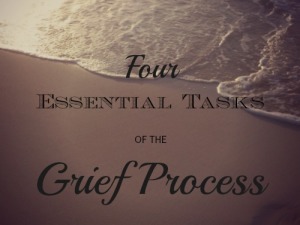There are few things as disruptive to our lives as the loss of a loved one. Whether the death is sudden or long-expected, whether it is at the end of a long life or “too soon,” whether mother or father, husband or wife, son or daughter, relative or friend, these losses impact us. They change the landscape of our world. And then we have to grieve.
What can you expect when you’re grieving? What does the process of grief involve?
The lens I have found most helpful to look through to view the grief process is William Worden’s “Four Tasks of Mourning.”
Worden, in his classic book, Grief Counseling and Grief Therapy, says there are four tasks that need to be accomplished in order to adapt to a loss:
- To accept the reality of the loss
- To work through the pain of grief
- To adjust to an environment in which the deceased is missing
- To find an enduring connection with the deceased while embarking on a new life
1) Accept Reality
Grief work involves getting past the shock and disbelief of the loss. It means not just intellectual awareness that the loved one is dead, but emotional acceptance of that fact. “He is gone; she is gone. I will not see them alive again on this earth.”
We know this task is completed when we no longer flip into denial and disbelief, when we no longer catch ourselves bumping up against the loved one’s absence with a sense of painful shock. This takes time, time for the hard reality to sink in.
2) Work Through the Pain
“It is impossible to lose someone you have been deeply attached to without experiencing some level of pain” (Worden, 2002). Grief is a big tangled ball of yarn consisting of emotions such as anger, guilt, anxiety, helplessness, loneliness, and deep, deep sadness. It takes courage and persistence to patiently untangle the yarn and allow yourself to emotionally experience grief.
People get stuck in this stage and, unfortunately, make the grief process take longer when they try to avoid the pain of grief by not feeling. Attempts to numb the pain or to avoid or suppress the difficult emotions are counterproductive in the long term.
Grief has been compared to waves of the ocean. Early in the grief process, each wave of emotion crashes onto us, knocking us off our feet. But as we do the work of task two, the pain of the loss gradually becomes less, and the waves of emotion become smaller. We can still feel their motion, but we are able to keep our footing.
3) Adjust
I think of this task as the task of coping. The loved ones filled a role in our lives, and when they are gone, we are often faced with the necessity of learning new skills and taking on new roles ourselves. We have to make sense of the death, and figure out who we are without that person in our lives.
If we refuse to, for example, learn to pay the bills or mow the lawn after the death of a partner who took care of those things, if we drag our feet at finding other people to confide in after the death of a dearly loved parent who was always there for us, then we are avoiding the hard work of adjusting.
4) Re-Integrate
In this task, the griever finds a way to carry the loved one with them while continuing on in life. This means being willing to love and to live and to look to the future, knowing that you are not forgetting your loved one, but rather remembering them in a different way.
Author Anne Lamott says:
You will lose someone you can’t live without, and your heart will be badly broken, and the bad news is that you never completely get over the loss of your beloved. But this is also the good news. They live forever in your broken heart that doesn’t seal back up. And you come through. It’s like having a broken leg that never heals perfectly — that still hurts when the weather gets cold, but you learn to dance with the limp.
Grief is a dark and difficult process, one that takes far longer than our culture leads us to expect. The tasks of grief cannot be rushed; each one takes time and energy.
We admire heroes who set out on quests: Slay the dragon. Find the Holy Grail. Destroy the One Ring. If you have lost a loved one, this is your mission, these are your nearly-impossible tasks: Accept reality. Work through the pain. Adjust. Re-integrate.
I wish you courage and grace for the journey.
Question: What do you think? Do these tasks ring true to you? Are you in the grief process working on one or more of these tasks? You can leave a comment by clicking here.


Please note: I reserve the right to delete comments that are offensive or off-topic.